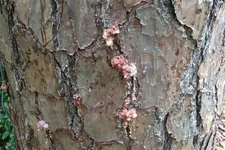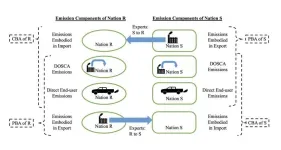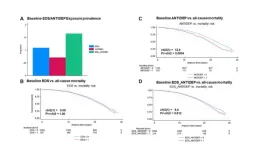(Press-News.org) Research suggests that males and females differ in their experience of pain, but up until now, no one knew why. In a recent study published in BRAIN, University of Arizona Health Sciences researchers became the first to identify functional sex differences in nociceptors, the specialized nerve cells that produce pain.
The findings support the implementation of a precision medicine-based approach that considers patient sex as fundamental to the choice of treatment for managing pain.
“Conceptually, this paper is a big advance in our understanding of how pain may be produced in males and females,” said Frank Porreca, PhD, research director of the Comprehensive Center for Pain & Addiction at UArizona Health Sciences and professor and associate department head of pharmacology at the UArizona College of Medicine – Tucson. “The outcomes of our study were strikingly consistent and support the remarkable conclusion that nociceptors, the fundamental building blocks of pain, are different in males and females. This provides an opportunity to treat pain specifically and potentially better in men or women, and that’s what we’re trying to do.”
Porreca and the research team focused their study on the excitability of nociceptor cells located near the spinal cord in the dorsal root ganglion. Nociceptors, when activated by damage or injury, send a signal through the spinal cord to the brain that results in the perception of pain. Nociceptors are also adaptable in their response to injury.
For example, touching a hot stove is a high-intensity stimulus, while a shirt collar rubbing a sunburn is low-intensity, yet both produce the perception of pain. In injury settings such as sunburn, pain medications, including nonsteroidal anti-inflammatory drugs such as ibuprofen, work by normalizing the threshold for nociceptor activation, thereby blocking pain produced by low-intensity stimuli such as the rubbing of a shirt.
Following up on prior research on the relationship between chronic pain and sleep, unexpected sex differences led Porreca to choose two substances – prolactin and orexin B – for this study. Prolactin is a hormone responsible for lactation and breast tissue development; orexin is a neurotransmitter that helps to promote staying awake. However, both prolactin and orexin have many other functions that are only now being revealed.
The research team used tissue samples from male and female mice, nonhuman primates and humans to test the effect of prolactin and orexin B on nociceptor activation thresholds that can allow low-intensity stimuli to produce pain.
“What we found is that in males and females – animals or humans – what changes the thresholds of the nociceptors can be completely different,” Porreca said. “When we added the sensitizing substances that lower these thresholds for activation, we found that prolactin only sensitizes female cells and not male cells, and orexin B only sensitizes male cells and not female cells. The startling conclusion from these studies is that there are male nociceptors and female nociceptors, something that has never previously been recognized.”
Taking the research one step further, they then blocked prolactin signaling and orexin B signaling and examined the effect on the threshold for activation of the nociceptors. As anticipated, blocking prolactin signaling reduced nociceptor activation in females and had no effect in males, while blocking orexin B signaling was effective in males and not in females.
“Until now, the assumption has been that the driving mechanisms that produce pain are the same in men and women,” Porreca said. “What we found is that the basic, underlying mechanisms that result in the perception of pain are different in male and female mice, in male and female nonhuman primates, and in male and female humans.”
The findings suggest a new way to approach treating pain conditions, many of which are female prevalent. Migraine and fibromyalgia, for example, have female-to-male ratios of 3:1 and 8 or 9:1, respectively.
Porreca believes preventing prolactin-induced nociceptor sensitization in females may represent a viable approach for the treatment of female-prevalent pain disorders, while targeting orexin B-induced sensitization might improve the treatment of pain conditions associated with nociceptor activation in males.
Moving forward, Porreca and his team will continue looking for other sexually dimorphic mechanisms of pain while building on this study to seek viable ways to prevent nociceptor sensitization in females and males. He is encouraged by his recent discovery of a prolactin antibody, which could prove useful in females, and the availability of orexin antagonists that are already Food and Drug Administration-approved for the treatment of sleep disorders.
“We are bringing the concept of precision medicine – taking a patient’s genetics into account to design a therapy – to the treatment of pain,” Porreca said. “The most basic genetic difference is, is the patient male or female? Maybe that should be the first consideration when it comes to treating pain.”
Porreca’s University of Arizona Health Sciences co-authors include associate professor Edita Navratilova, PhD; assistant professor Laurent Martin, PhD; postdoctoral research associate Grace Lee, PhD; doctoral student Mahdi Dolatyari; research program manager Stefanie Mitchell; researcher Xu Yue and former doctoral student Harrison Stratton, PhD; all of the College of Medicine – Tucson Department of Pharmacology; and Mohab Ibrahim, MD, PhD, professor in the College of Medicine – Tucson Department of Anesthesiology and medical director of the Comprehensive Center for Pain & Addiction. Other co-authors include assistant professor Aubin Moutal, PhD, research assistant professor Liberty François-Moutal, PhD, doctoral student Nicolas Dumaire and graduate research assistant Lyuba Salih, all from Saint Louis University; and Andre Ghetti and Tamara Cotta of Anabios in San Diego.
END
Study shows first evidence of sex differences in how pain can be produced
Research suggests that males and females differ in their experience of pain, but up until now, no one knew why. In a recent study published in BRAIN, University of Arizona Health Sciences researchers became the first to identify functional sex differences
2024-06-10
ELSE PRESS RELEASES FROM THIS DATE:
Hubble finds surprises around a star that erupted 40 years ago
2024-06-10
Astronomers have used new data from NASA's Hubble Space Telescope and the retired SOFIA (Stratospheric Observatory for Infrared Astronomy) as well as archival data from other missions to revisit one of the strangest binary star systems in our galaxy – 40 years after it burst onto the scene as a bright and long-lived nova. A nova is a star that suddenly increases its brightness tremendously and then fades away to its former obscurity, usually in a few months or years.
Between April and September 1975, the binary system HM Sagittae (HM Sge) grew 250 times brighter. Even more unusual, it did not rapidly fade away as novae commonly do, but has ...
NASA’s Webb opens new window on supernova science
2024-06-10
Peering deeply into the cosmos, NASA’s James Webb Space Telescope is giving scientists their first detailed glimpse of supernovae from a time when our universe was just a small fraction of its current age. A team using Webb data has identified 10 times more supernovae in the early universe than were previously known. A few of the newfound exploding stars are the most distant examples of their type, including those used to measure the universe's expansion rate.
"Webb is a supernova ...
May research news from the Ecological Society of America
2024-06-10
The Ecological Society of America (ESA) presents a roundup of four research articles recently published across its six esteemed journals. Widely recognized for fostering innovation and advancing ecological knowledge, ESA’s journals consistently feature illuminating and impactful studies. This compilation of papers explores how wolf reintroduction affects other carnivores, how drought and grazing snails together drive salt marsh productivity, the key to an invasive fish’s success and the plight of backyard trees, ...
Taking the fall: How stunt performers struggle with reporting head trauma
2024-06-10
In the heart-pounding action scenes of your favorite blockbuster, it's not always the A-list actor taking the risks but the unsung heroes—stunt performers—who bring those breathtaking moments to life. However, behind the glamour lies a grim reality: the reluctance of these daredevils to report head trauma, fearing it could jeopardize their careers.
In the recently released blockbuster, “The Fall Guy,” audiences get a behind-the-scenes look at what stunt professionals go through to create those most thrilling moments, and although this film celebrates these skilled professionals, it does not highlight the impact the stunts can have on their health.
Ohio ...
Income inequality and carbon dioxide emissions have a complex relationship
2024-06-10
Income inequality and carbon dioxide emissions for high-income nations such as the United States, Denmark and Canada are intrinsically linked – but a new study from Drexel University has taken a deeper look at the connection and found this relationship is less fixed, can change over time, and differ across emission components. The findings could help countries set a course toward reducing emissions of the harmful greenhouse gas and alleviating domestic income inequality at the same time.
The ...
Yuan elevated to IEEE senior member
2024-06-10
Jinghui Yuan, an R&D staff member in the Applied Research for Mobility Systems group at the Department of Energy’s Oak Ridge National Laboratory, has been elevated to a senior member of the Institute of Electrical and Electronics Engineers, or IEEE.
Senior member status is the highest grade of IEEE and requires extensive experience that reflects professional accomplishments. Only 10% of IEEE’s more than 450,000 members achieve this level.
As a transportation engineer in the Buildings and Transportation Science Division, Yuan’s research focuses on intelligent transportation systems, crash risk prediction, big data analytics, deep learning, traffic simulation and ...
Passive heat exposure increases stress on the heart, posing risk to adults with history of CAD
2024-06-10
Embargoed for release until 5:00 p.m. ET on Monday 10 June 2024
Annals of Internal Medicine Tip Sheet
@Annalsofim
Below please find summaries of new articles that will be published in the next issue of Annals of Internal Medicine. The summaries are not intended to substitute for the full articles as a source of information. This information is under strict embargo and by taking it into possession, media representatives are committing to the terms of the embargo not only on their own behalf, but also on behalf of the organization they represent.
----------------------------
1. ...
Feeling rough after your COVID shot? Congrats, it’s working!
2024-06-10
Feeling Rough After Your COVID Shot? Congrats, It’s Working!
Headache, chills, tiredness may be evidence of a supercharged defense, according to UCSF-led study.
Fewer than 1 in 4 people in the United States have received last year’s updated COVID-19 vaccine, despite a death toll of more than 23,000 Americans this year.
One of the most common reasons for bypassing the COVID vaccine is concern about side effects like tiredness, muscle and joint pain, chills, headache, fever, nausea and feeling generally unwell. But a new study, led by UC San Francisco, has found that the symptoms indicate a robust immune response that is likely to ...
Depression, antidepressants, epigenetic age acceleration, and mortality in postmenopausal women
2024-06-10
“The study examined the impact of depressive symptoms, antidepressant use, and epigenetic age acceleration on all-cause mortality in postmenopausal women.”
BUFFALO, NY- June 10, 2024 – A new research paper was published in Aging (listed by MEDLINE/PubMed as "Aging (Albany NY)" and "Aging-US" by Web of Science) Volume 16, Issue 10, entitled, “Relationships of depression and antidepressant use with epigenetic age acceleration and all-cause mortality among postmenopausal women.”
In this new study, researchers May A. Beydoun, Hind A. Beydoun, Jason Ashe, Michael F. Georgescu, Steve Horvath, Ake Lu, Anthony S. Zannas, ...
Researchers engineer new approach for controlling thermal emission
2024-06-10
UNIVERSITY PARK, Pa. — If a material absorbs light, it will heat up. That heat must go somewhere, and the ability to control where and how much heat is emitted can protect or even hide such devices as satellites. An international team of researchers, including those from Penn State, has developed a novel method for controlling this thermal emission, with what they called promising implications for thermal management and thermal camouflage technologies.
The team published their work on June 7 in the print edition of Science.
Led by researchers at The University of Manchester’s National Graphene Institute ...
LAST 30 PRESS RELEASES:
Numbers in our sights affect how we perceive space
SIMJ announces global collaborative book project in commemoration of its 75th anniversary
Air pollution exposure and birth weight
Obstructive sleep apnea risk and mental health conditions among older adults
How talking slows eye movements behind the wheel
The Ceramic Society of Japan’s Oxoate Ceramics Research Association launches new international book project
Heart-brain connection: international study reveals the role of the vagus nerve in keeping the heart young
Researchers identify Rb1 as a predictive biomarker for a new therapeutic strategy in some breast cancers
Survey reveals ethical gaps slowing AI adoption in pediatric surgery
Stimulant ADHD medications work differently than thought
AI overestimates how smart people are, according to HSE economists
HSE researchers create genome-wide map of quadruplexes
Scientists boost cell "powerhouses" to burn more calories
Automatic label checking: The missing step in making reliable medical AI
Low daily alcohol intake linked to 50% heightened mouth cancer risk in India
American Meteorological Society announces Rick Spinrad as 2026 President-Elect
Biomass-based carbon capture spotlighted in newly released global climate webinar recording
Illuminating invisible nano pollutants: advanced bioimaging tracks the full journey of emerging nanoscale contaminants in living systems
How does age affect recovery from spinal cord injury?
Novel AI tool offers prognosis for patients with head and neck cancer
Fathers’ microplastic exposure tied to their children’s metabolic problems
Research validates laboratory model for studying high-grade serous ovarian cancer
SIR 2026 delivers transformative breakthroughs in minimally invasive medicine to improve patient care
Stem Cell Reports most downloaded papers of 2025 highlight the breadth and impact of stem cell research
Oxford-led study estimates NHS spends around 3% of its primary and secondary care budget on the health impacts of heat and cold in England
A researcher’s long quest leads to a smart composite breakthrough
Urban wild bees act as “microbial sensors” of city health.
New study finds where you live affects recovery after a hip fracture
Forecasting the impact of fully automated vehicle adoption on US road traffic injuries
Alcohol-related hospitalizations from 2016 to 2022
[Press-News.org] Study shows first evidence of sex differences in how pain can be producedResearch suggests that males and females differ in their experience of pain, but up until now, no one knew why. In a recent study published in BRAIN, University of Arizona Health Sciences researchers became the first to identify functional sex differences






